| 17 December |
• yesterday • tomorrow |
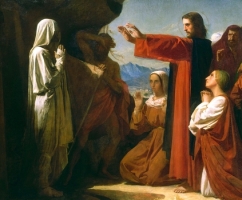
• Lazarus of the Four Days
• Lazarus the Resurrected
• Lazare...
The brother of Saint Martha and Saint Mary of Bethany. He was the man whom Jesus raised from the dead after having been dead and in his tomb for four days. The Bible does not trace his history after the miracle, but tradition says he became a missionary to Gaul, the first bishop of Marseilles, France, and a martyr in the persecutions of Domitian.
• beheaded in the 1st century in a cave near Marseilles, France
• some relics remain in Marseilles
• some relics later enshrined in the Cathedral of Saint Lazare, Autun, France
• Autun, France, diocese of
• Marseille, France, archdiocese of
Now a man was ill, Lazarus from Bethany,a the village of Mary and her sister Martha. Mary was the one who had anointed the Lord with perfumed oil and dried his feet with her hair; it was her brother Lazarus who was ill. So the sisters sent word to him, saying, "Master, the one you love is ill."
When Jesus heard this he said, "This illness is not to end in death, but is for the glory of God, that the Son of God may be glorified through it."
Now Jesus loved Martha and her sister and Lazarus. So when he heard that he was ill, he remained for two days in the place where he was. Then after this he said to his disciples, "Let us go back to Judea."
The disciples said to him, "Rabbi, the Jews were just trying to stone you, and you want to go back there?"
Jesus answered, "Are there not twelve hours in a day? If one walks during the day, he does not stumble, because he sees the light of this world. But if one walks at night, he stumbles, because the light is not in him." He said this, and then told them, "Our friend Lazarus is asleep, but I am going to awaken him."
So the disciples said to him, "Master, if he is asleep, he will be saved."
But Jesus was talking about his death, while they thought that he meant ordinary sleep. So then Jesus said to them clearly, "Lazarus has died. And I am glad for you that I was not there, that you may believe. Let us go to him."
So Thomas, called Didymus, said to his fellow disciples, "Let us also go to die with him."
When Jesus arrived, he found that Lazarus had already been in the tomb for four days. Now Bethany was near Jerusalem, only about two miles away. And many of the Jews had come to Martha and Mary to comfort them about their brother. When Martha heard that Jesus was coming, she went to meet him; but Mary sat at home. Martha said to Jesus, "Lord, if you had been here, my brother would not have died. [But] even now I know that whatever you ask of God, God will give you."
Jesus said to her, "Your brother will rise."
Martha said to him, "I know he will rise, in the resurrection on the last day."
Jesus told her, "I am the resurrection and the life; whoever believes in me, even if he dies, will live, and everyone who lives and believes in me will never die. Do you believe this?"
She said to him, "Yes, Lord. I have come to believe that you are the Messiah, the Son of God, the one who is coming into the world."
When she had said this, she went and called her sister Mary secretly, saying, "The teacher is here and is asking for you."
As soon as she heard this, she rose quickly and went to him. For Jesus had not yet come into the village, but was still where Martha had met him. So when the Jews who were with her in the house comforting her saw Mary get up quickly and go out, they followed her, presuming that she was going to the tomb to weep there. When Mary came to where Jesus was and saw him, she fell at his feet and said to him, "Lord, if you had been here, my brother would not have died."
When Jesus saw her weeping and the Jews who had come with her weeping, he became perturbed and deeply troubled, and said, "Where have you laid him?"
They said to him, "Sir, come and see."
And Jesus wept. So the Jews said, "See how he loved him." But some of them said, "Could not the one who opened the eyes of the blind man have done something so that this man would not have died?"
So Jesus, perturbed again, came to the tomb. It was a cave, and a stone lay across it. Jesus said, "Take away the stone."
Martha, the dead man's sister, said to him, "Lord, by now there will be a stench; he has been dead for four days."
Jesus said to her, "Did I not tell you that if you believe you will see the glory of God?"
So they took away the stone. And Jesus raised his eyes and said, "Father, I thank you for hearing me. I know that you always hear me; but because of the crowd here I have said this, that they may believe that you sent me." And when he had said this, he cried out in a loud voice, "Lazarus, come out!"
The dead man came out, tied hand and foot with burial bands, and his face was wrapped in a cloth. So Jesus said to them, "Untie him and let him go." - John 11:1-44
https://catholicsaints.info/saint-lazarus-of-bethany/
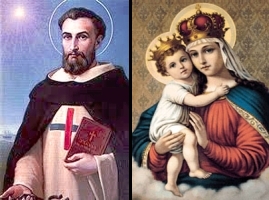
Born to the Provencal nobility. Educated at Aix, France, then lived as a hermit at Faucon, France. Earned a doctorate in theology at Paris, France. Ordained in 1197.
At the first Mass he celebrated, John received a vision of an angel clothed in white with a red and blue cross on his breast. The angel placed his hands on the heads of two slaves who knelt beside him. Later, when sitting beside a stream with fellow hermit, Saint Felix of Valois, the two were given the vision of a white stag between whose antlers was suspended a blue and red cross. With the encouragement of Pope Innocent III, he founded the Hospitaler Order of the Most Holy Trinity and of Captives (Trinitarians or Redemptionists) to ransom Christian prisoners of the Moors (the Mathurins). The congregation received papal approval in 1209. The clothing seen in the vision of the angel became the habit of the order, the Scapular of the Most Holy Trinity was instituted, the Order was placed under the protection of Mary under the title of Our Lady of Good Remedy, and John was the first superior general. Hundreds of prisoners were ransomed and returned to their homes.
Because John's life contains such good story elements (visions, prisoners, rescued knights, etc.), John became the topic for several biographies in the Middle Ages, many of these were loaded heavily with fiction. Today there are around 600 members of the Order working in prison ministries in over twenty countries, and they recently celebrated their 800 year anniversary.
23 June 1160 at Faucon, Provence, France
• 12 December 1223 at Rome, Italy of natural causes
• relics in Madrid, Spain
21 October 1666 by Pope Alexander VII (cultus confirmed)
• purse
• man in Trinitarian habit (white with blue and red cross on the breast) with chains in his hands or at his feet, captives near him, and his mitre at his feet
• receiving the scapular from the Holy Trinity
• with Our Lady of Good Remedy who hands him a bag of money
• with Saint Felix of Valois
• with the angel and the two captives from his vision in the background
• cannon ball and sword (referring to prisoners of war he ransomed)
https://catholicsaints.info/saint-john-of-matha/
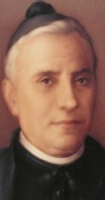
Born to a large and pious family. Dedicated to Our Lady at age 5 by his mother. Educated by the Piarist Fathers in Barbastro, Spain, and then in seminaries at Lleida and Urgell in Spain. Ordained on 9 April 1859. Private secretary to the bishop of Urgell. Seminary librarian. Chancery administrator. Secretary for pastoral visitations. Founded the Congregation of the Sons of the Holy Family in 1864. Founded the Missionary Daughters of the Holy Family of Nazareth in 1874. Both were dedicated to serving Christian family, teaching, and parish ministry, and today work throughout Europe, Africa, and the Americas. Founded schools and ministerial centers in several Spanish towns. Wrote books and pamphlets encouraging devotion to the Holy Family, to help the spiritual formation of the members of his congregations, to help families in trouble, and about school management. Founded the magazine La Sagrada Familia. Worked for the construction of a temple in Barcelona dedicated to the Holy Family, which was built by Servant of God Antonio Gaudí.
7 January 1833 in Trempe, Catalonia, Spain
17 December 1901 in San Andréd de Palomar, Spain of natural causes
16 May 2004 by Pope John Paul II in Rome, Italy
"The Holy Spirit, whom the Father will send in my name, will teach you everything and remind you of all that I told you." (John 14: 26) From the beginning, the Holy Spirit has brought forth men and women who have remembered and spread the truth revealed by Jesus. One of these was Saint José Manyanet, a true apostle of the family. Inspired by the school of Nazareth, he carried out his plan of personal sanctity and heroically devoted himself to the mission that the Spirit entrusted to him. He founded two religious congregations. A visible symbol of his apostolic zeal is also the temple of the Holy Family of Barcelona. May Saint José Manyanet bless all families and help them follow the example of the Holy Family in their homes! - Pope John Paul II's canonization homily for Saint José
https://catholicsaints.info/saint-josep-manyanet-y-vives/
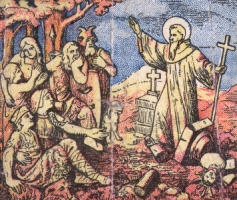
• Apostle of the Saxons
• Apostle of Germany
• Sturm, Sturmius
Educated by Saint Wigbert at Fritzlar Abbey under the direction of Saint Boniface. Friend of Charlemagne. Priest. Missionary in Westphalia for three years. Hermit at Hersfeld, where he tried to establish a monastery in 742, but had to flee ahead of Saxon raiders. Founded the Fulda monastery in 744, and served as its first abbot. He became the first German to become a Benedictine, and placed his house under the Benedictine Rule; it became a regional center for learning and spirituality. He became involved in a drawn-out dispute with bishop Saint Lull of Mainz, Germany about jurisdiction over the monastery, and in 763 Pepin banished Sturmi from Fulda. His brother monks rebelled, and persuaded Pepin to recall him after two years of exile. Sturmi evangelized the Saxons but met with little success as they associated him with the brutality of the rulers Charlemagne and Pepin.
Bavaria, Germany
779 in Fulda, Germany of natural causes
1139 by Pope Innocent II
https://catholicsaints.info/saint-sturmi-of-fulda/
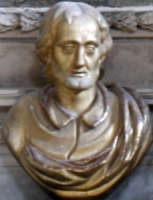
• 17 May (Orthodox calendar)
• 29 March (Orthodox calendar)
• 16 December (Palestinian-Georgian calendar)
• 19 October (Acta Sanctorum)
• 18 December (Bulgaria)
Orphaned at five months of age. Sold into slavery in Egypt as an adult, he converted his pagan "owner" to Christianity, and was promptly freed. He then withdrew from society to live as a hermit on Mount Sinai. Monk and then abbot of the Monastery of Saint Theodosius in Palestine. Tried to raise Greek troops to oppose the Persian invasion and destruction of Jerusalem in 614. Chosen Bishop and Greek Orthodox Patriarch of Jerusalem. Helped re-build the city after its conquest and damage by the Persians.
Sebasteia, Cappadocia (in modern Turkey)
• 17 December 630 of natural causes
• buried in the Church of the Eleona on the Mount of Olives
https://catholicsaints.info/saint-modestus-of-jerusalem/

Gaël, Gaëlle, Gicquel, Giguel, Giquel, Iudicael, Iudicallus, Jekel, Jezek, Jezekael, Jezekel, Jikael, Jikel, Jude, Judhael, Judhaël, Judhel, Judiakel, Judicaël, Juhel, Juzel, Jézéquel
Son of the king of Domnonia, Brittany (in modern France). Brother of Saint Joducus. Well-loved king of Domnonia. Abdicated to become a monk, living his last 20 years in a monastery of Gael in Vannes, France.
• 658 of natural causes
• buried at Paimpont Abbey
• most relics were destroyed in the French Revolution
• remaining relics in the church of Saint-Meen
• Gaël, France
• Paimpont, France
man with a crown at his feet and a broom in his hand to show that he gave up the royal life for a humble one
https://catholicsaints.info/saint-judicael/
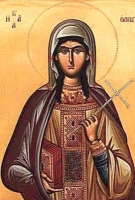
Born to a wealthy Constantinople noble family. Orphaned as a child. Married to Nebridius, prefect of Constantinople. Widowed, she refused several offers of marriage, and devoted herself to the Church. Deaconess. She led a non-cloistered group of prayerful women in her home, and devoted herself to charity. She built a hospital and orphanage, sheltered monks expelled from Nitria, and gave away so much of her wealth that her friend, Saint John Chrysostom, told her she was over-doing. In 404, due to her support of Saint John, she was persecuted, her community disbanded, her house seized and sold, and she spent the rest of her days in exile in Nicomedia.
at Constantinople
25 July 408 at Nicomedia following a long illness
https://catholicsaints.info/saint-olympias-of-constantinople/
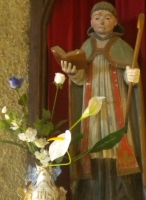
Briach, Briac, Briachus, Briag, Briagenn
Born to the Irish nobility. Monk in Wales. Friend and evangelist with Saint Tudwal. Priest. He founded a monastery in Guingamp, Brittany, France, and served as its first abbot. Pilgrim to Rome.
Irish
• 627 in Bourbiac, France of natural causes
• buried in the church of Bourbiac
• against epilepsy
• against mental illness
• against migraines
O holy Briach, thou dost teach us the value of renunciation, for thou didst renounce the world to seek salvation. Therefore we pray, that our lives may show forth the virtue of self denial and thereby attain the eternal salvation of our souls. - troparion of Saint Briach
https://catholicsaints.info/saint-briarch/
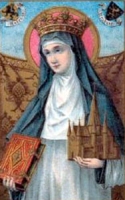
Born to the nobility, the daughter of Saint Pepin of Landen, mayor of the palace, and Saint Ida of Nivelles. Sister of Saint Gertrude of Nivelles. Married to Ansegilius, son of Saint Arnulf of Metz. Mother of Pepin of Herstal, founder of the Carolingian dynasty of rulers in France, in 635, and of Martin of Laon.
On the death of her husband in 691 in a hunting accident, Begga took the veil, founded founded seven churches, and built a convent at Andenne on the Meuse River in France where she spent the rest of her days as abbess.
693 at Andenne on the Meuse River in France
https://catholicsaints.info/saint-begga-of-ardenne/
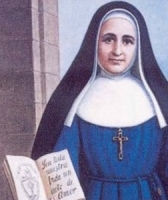
• Matilde of the Sacred Heart
• Matilde Tellez Robles
Founded the Congregation of the Daughters of Mary, Mother of the Church.
30 May 1841 in Robledillo de la Vera, Cáceres. Spain as Matilde Tellez Robles
17 December 1902 in Don Benito, Badajoz, Spain of natural causes
21 March 2004 by Pope John Paul II
https://catholicsaints.info/blessed-matilde-del-sagrado-corazon-tellez-robles/
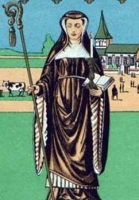
Vivina
She received many offers of marriage but turned them all down. At age 23 she became a hermitess near Brussels, Belgium. Her reputation soon attracted disciples. For them she built a Benedictine convent of Grand-Brigard on land donated by Count Godfrey of Brabant, and served as its first abbess.
1103 in Oisy, Flanders, Belgium
c.1170 at Grand-Brigard Abbey, Brabant, Belgium of natural causes
https://catholicsaints.info/saint-wivina/
Dudec, Thudec, Thudoc, Tudec, Tudes, Tudoc
Brother of Saint Cadfan. Probably lived as a hermit. Several Welsh churches are named for him.
Welsh
6th century
By thy labours for Christ, O Father Tydecho, thou didst win the crown of eternal glory and didst light the way into the Ark of Salvation. Wherefore, O Saint, intercede for us that in following thee we may be found worthy of Christ's great mercy. - troparion of Saint Tydecho
https://catholicsaints.info/saint-tydecho/
Father José Mariano of the Angels
Discalced Carmelite priest. Martyred in the Spanish Civil War.
24 November 1912 in Murcia, Spain
17 December 1936 in Badalona, Barcelona, Spain
28 October 2007 by Pope Benedict XVI
https://catholicsaints.info/blessed-mariano-alarcon-ruiz/
Mercedarian tertiary and knight. Known as a man of great learning and personal piety. Led a Christian army into Algiers to oppose the Saracens. Martyr.
cut to pieces near Trovandosi, Algeria in 1418
https://catholicsaints.info/blessed-peter-of-spain/
Mezenceul
Disciple of Saint Martin of Tours. Abbot. Founder of Our Lady of Cunault abbey in France.
5th century
https://catholicsaints.info/saint-maxentiolus/
Daughter of the count of Vianden. Dominican nun against the fierce opposition of her father.
1283 of natural causes
https://catholicsaints.info/saint-yolanda/
Approximately 60 Christian soldiers in the imperial Roman army of emperor Heraclius; they were murdered as a group for their faith by invading Saracen Muslims. We know little more than the names of some of them - Abraham, Calaoicus, Ciriacus, Conón, Epifanius, Eugene, Florian, George (9 with this name), John (10 with this name), Marino, Marmises, Muselio, Paul (3 with this name), Paulino, Philoxenus, Photino, Stephen (2 with this name), Teodosio, Teopento, Theodore (5 with this name), Thomas and Zitas (2 with this name).
638 in Eleutheropolis (Beit Jibrin), Palestine
https://catholicsaints.info/martyrs-of-eleutheropolis/
• Cristoforo di Collesano
CatholicSaints.Info Portable Edition